The Wearable Translator Market is estimated to be valued at USD 270.2 million in 2025 and is projected to reach USD 684.9 million by 2035, registering a compound annual growth rate (CAGR) of 9.7% over the forecast period.
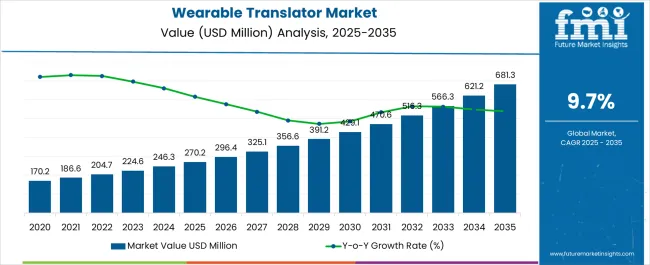
| Metric | Value |
|---|---|
| Wearable Translator Market Estimated Value in (2025 E) | USD 270.2 million |
| Wearable Translator Market Forecast Value in (2035 F) | USD 684.9 million |
| Forecast CAGR (2025 to 2035) | 9.7% |
The wearable translator market is gaining momentum, fueled by the intersection of artificial intelligence, voice recognition, and global mobility trends. Advancements in natural language processing and machine learning have significantly improved translation accuracy and reduced latency, enhancing user experience in real-time communication.
Industry updates and technology announcements have underscored the integration of multilingual capabilities into compact wearable devices, aligning with rising consumer demand for seamless cross-border interaction. The growth of international travel, cross-cultural business engagements, and the increasing adoption of digital tools for language accessibility are driving market penetration.
Strategic partnerships between technology firms and travel service providers have expanded product availability across consumer segments. Furthermore, declining hardware costs and enhanced connectivity options, such as 5G networks, have strengthened product adoption. Looking forward, the market is expected to benefit from continued investments in wearable technology, cloud-based AI translation platforms, and the expansion of applications beyond travel into healthcare, education, and global commerce.
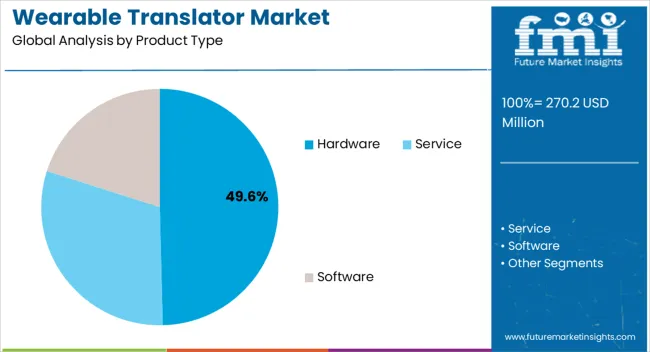
The Hardware segment is projected to contribute 49.6% of the wearable translator market revenue in 2025, maintaining its lead due to consumer preference for dedicated translation devices. Growth in this segment has been supported by the reliability and offline functionality that hardware-based translators provide, particularly in areas with limited internet connectivity.
Reports from technology publications and product announcements have emphasized the value of dedicated devices in delivering longer battery life, robust microphones, and noise-cancellation features that enhance real-time translation accuracy. Consumers and businesses have increasingly favored standalone hardware over software-only solutions because of their ease of use and ergonomic design.
Additionally, the market has seen a steady expansion of compact and stylish devices that cater to both professional and casual users. As manufacturers continue to innovate with features like AI-based contextual translation and integration with wearable ecosystems, the Hardware segment is expected to sustain its strong adoption curve and reinforce its position as the largest product type category.
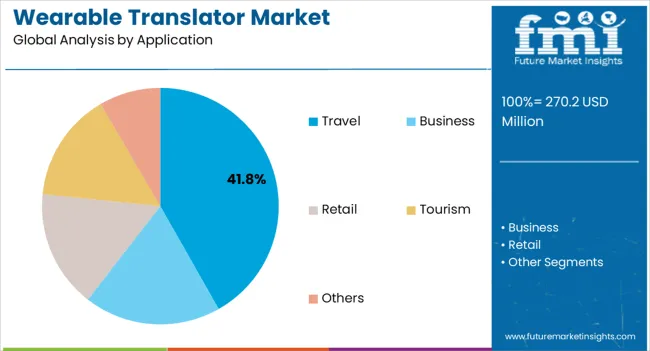
The Travel segment is projected to account for 41.8% of the wearable translator market revenue in 2025, leading application demand due to the surge in international tourism and cross-border mobility. The segment’s growth has been propelled by the increasing need for accessible language solutions that facilitate smoother interactions between travelers and locals.
Tourism boards and travel companies have emphasized the role of technology in enhancing visitor experiences, encouraging broader use of portable translation devices. Moreover, wearable translators have been widely adopted by frequent travelers for their convenience in navigating airports, hotels, and cultural sites without language barriers.
The integration of instant translation capabilities with navigation apps and travel services has further boosted appeal within this segment. As global travel continues to recover and expand, the demand for wearable translators in the Travel segment is expected to grow steadily, reinforced by rising disposable incomes, digital adoption, and consumer prioritization of hassle-free communication abroad.
The primary driver for the wearable translator is the need for real-time translation of one language to another to improve the end-user experience. A rapid increase in offline memory development to satisfy escalating customer requirements also contribute to the growth of the wearable translator market. It offers other benefits such as durable battery life, voice activation, offline recognition of over 50,000 words and phrases, updates in different languages, easy language switching, and many more.
Since most of the applications on the Play Store supporting the Android operating system are free to use, the high cost of the device hampers the market growth. Another issue is that the devices are coming with fewer languages and words associated with traveling. To use the newly developed languages, the devices must be purchased.
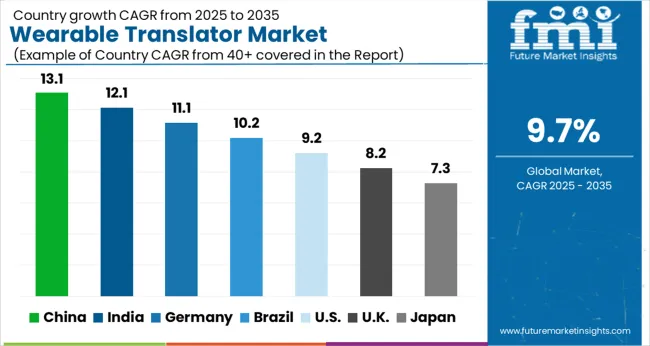
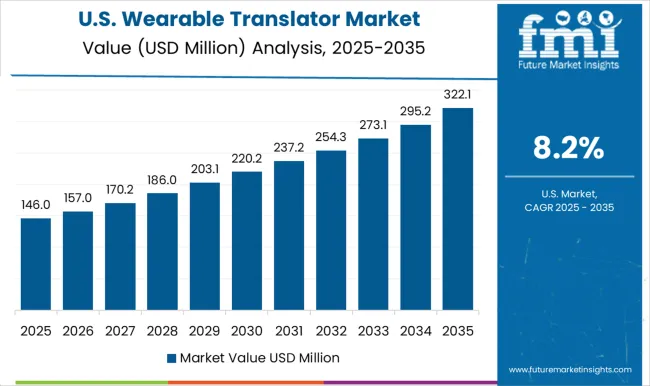
The demand for wearable translators has increased in the North American region. North America is anticipated to control a global wearable translator market share of 30% in 2025. In the last decade, the Latin American market for wearable translating devices has been driven by the increasing popularity and awareness of wearable and handheld devices.
The wearable translator market is expected to be boosted by technological advancements such as offline memory and voice recognition. Software as a translator component is poised also improve the quality of applications.
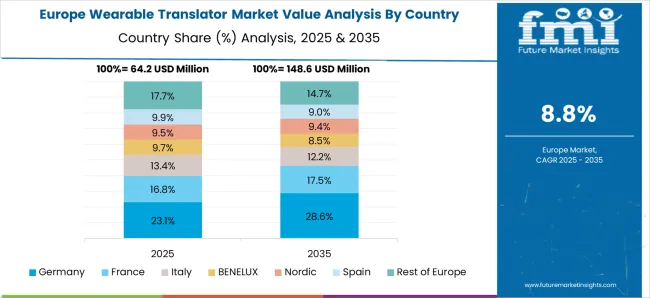
The Europe wearable translator market is predicted to experience significant growth and hold a market share of 29% in 2025. With the emergence of innovative technology in wearable translator devices, there are profound effects on product design, development, manufacturing, marketing, sales, and after-sales service.
Europe is the second-largest wearable translator market and is expected to continue its position in the global market during the forecast period. The increase in per capita disposable income among consumers and the favorable retail environment are the major factors driving the market in the Europe region.
Start-up Ecosystem in the Wearable Translator Market
There are a limited number of global players in the wearable translator market. Technological innovations and price differentiation are highly competitive in the market.
During the forecast period, high competition is expected to reduce the price of wearable translator products. To improve the quality, quantity, technology, services, and price of translator devices, vendors invest in R&D. Additionally, existing global players are increasing their investments to ensure continuous customer-centric product innovation, which is likely to drive the market for wearable translator devices.
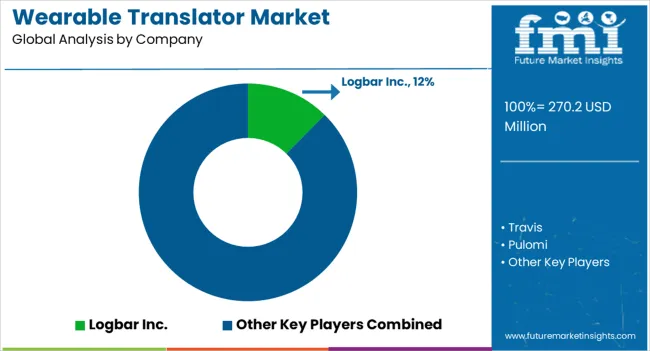
The wearable translator market is consolidated with a presence of a few strong players from around the globe. Some of the prominent players in the global Wearable Translator market include Logbar Inc., Travis, Pulomi, Waverly Labs, WT2, and others.
Emerging Trends in the wearable translator market are brought about as a result of the major players' adoption of several growth strategies, including product launches, acquisitions, and collaborations.
Some of the recent developments in the wearable translator market are as follows:
| Report Attribute | Details |
|---|---|
| Growth Rate | CAGR of 9.7% from 2025 to 2035 |
| Wearable Translator Market Value (2025) | USD 270.2 million |
| Wearable Translator Market Anticipated Forecast Value (2035) | USD 684.9 million |
| Base Year for Estimation | 2025 |
| Historical Data | 2020 to 2025 |
| Forecast Period | 2025 to 2035 |
| Quantitative Units | Revenue in USD Million and CAGR from 2025 to 2035 |
| Report Coverage | Revenue Forecast, Volume Forecast, Company Ranking, Competitive Landscape, Growth Factors, Trends and Pricing Analysis |
| Segments Covered | Product Type, Application, Region |
| Regions Covered | North America; Latin America; Western Europe; Eastern Europe; South Asia & Pacific; East Asia; Middle East & Africa (MEA) |
| Key Countries Profiled | United States, Canada, Brazil, Mexico, Germany, United Kingdom, France, Spain, Italy, Poland, Russia, Czech Republic, Romania, India, Bangladesh, Australia, New Zealand, China, Japan, South Korea, GCC Countries, South Africa, Israel |
| Key Companies Profiled | Logbar Inc.; Travis; Pulomi; Waverly Labs; WT2; Google; Jarvisen; Vasco Electronics LLC; Waverly Labs Inc.; Timekettle |
| Customization | Available Upon Request |
The global wearable translator market is estimated to be valued at USD 270.2 million in 2025.
The market size for the wearable translator market is projected to reach USD 684.9 million by 2035.
The wearable translator market is expected to grow at a 9.7% CAGR between 2025 and 2035.
The key product types in wearable translator market are hardware, service and software.
In terms of application, travel segment to command 41.8% share in the wearable translator market in 2025.






Full Research Suite comprises of:
Market outlook & trends analysis
Interviews & case studies
Strategic recommendations
Vendor profiles & capabilities analysis
5-year forecasts
8 regions and 60+ country-level data splits
Market segment data splits
12 months of continuous data updates
DELIVERED AS:
PDF EXCEL ONLINE
Wearable Injectors Market Size and Share Forecast Outlook 2025 to 2035
Wearable Defibrillator Patch Market Analysis - Size, Share, and Forecast Outlook 2025 to 2035
Wearable Fitness Tracker Market Size and Share Forecast Outlook 2025 to 2035
Wearable Cardioverter Defibrillator Market Size and Share Forecast Outlook 2025 to 2035
Wearable Electronics Market Size and Share Forecast Outlook 2025 to 2035
Wearable Band Market Size and Share Forecast Outlook 2025 to 2035
Wearable Gaming Technology Market Size and Share Forecast Outlook 2025 to 2035
Wearable Beauty Market Size, Growth, and Forecast for 2025 to 2035
Wearable Medical Robots Market - Trends & Forecast 2025 to 2035
Wearable Computing Market Trends – Growth & Forecast 2025 to 2035
Wearable Blood Pressure Monitor Market Trends and Forecast 2025 to 2035
Wearable Pregnancy Devices Market Trends and Forecast 2025 to 2035
Wearable Fitness Technology Market Insights - Trends & Forecast 2025 to 2035
Wearable Computing Devices Market Analysis - Size, Share & Forecast 2025 to 2035
Wearable Healthcare Devices Market Insights - Growth & Forecast 2024 to 2034
Wearable Medical Devices Market Growth – Trends & Forecast 2024-2034
Wearable Sleep Tracker Market Trends – Growth & Forecast 2024-2034
Wearable Sensor Market Growth – Trends & Forecast 2024-2034
Wearable Glucometers Market
Wearable Thermometers Market

Thank you!
You will receive an email from our Business Development Manager. Please be sure to check your SPAM/JUNK folder too.
Chat With
MaRIA